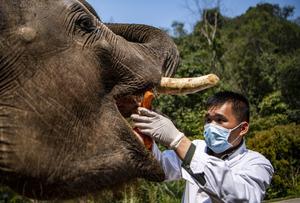The government is working to ensure a healthier and safer environment for flora and fauna. Yang Wanli reports.
 Members of staff pose for photos with panda cubs at the Giant Panda Breeding Research Base in Chengdu, Sichuan province, early last month, before the Spring Festival holiday. (ZHANG KEFAN / XINHUA)
Members of staff pose for photos with panda cubs at the Giant Panda Breeding Research Base in Chengdu, Sichuan province, early last month, before the Spring Festival holiday. (ZHANG KEFAN / XINHUA)
Longganhu National Nature Reserve in the central province of Hubei is having its busiest spring since it was established in 2009, and it has recorded a record number of migrant birds this year.
All the reserve's staff members are busy safeguarding the "visitors", who are scheduled to head north in the coming weeks.
The (species) bank is expected to standardize the collection and conservation of germplasm resources, boosting our ability to protect bioresources
Li Dezhu, head of the Kunming Institute of Botany
At the peak of the migration season, 145,000 birds were counted at the reserve. "During several observation periods, an average of about 140,000 birds could be seen throughout winter, a record high in the past decade," said Wu Xinzhou, head of the reserve's management office, adding that the previous record was 122,000 birds.
As spring draws near and the weather turns warmer, tundra swans are gradually leaving to continue their journey north. Other birds, such as white cranes, are still replenishing their energy for the trip ahead.
According to Wu, the numbers of several wild species broke records during the winter, including 13 white cranes and 105 hooded cranes, both under Level I protection, the highest in China.
"In addition to people's growing awareness of wildlife protection, the booming population of migratory birds in the reserve is the result of several factors, such as fishing bans and environmental restoration efforts," he said.
On Jan 1, a 10-year ban, outlawing all types of fishing except that for scientific research, started in the main channel of the Yangtze River, China's longest waterway, plus its major branches and two large connected lakes.
 Boats carrying rangers prepare to leave a dock on a tributary of the Yangtze River in Yunyang county, Chongqing, on Dec 31, 2020, for a mission to enforce the fishing moratorium. (LIU YANG / FOR CHINA DAILY)
Boats carrying rangers prepare to leave a dock on a tributary of the Yangtze River in Yunyang county, Chongqing, on Dec 31, 2020, for a mission to enforce the fishing moratorium. (LIU YANG / FOR CHINA DAILY)
The reserve, centered in Longgan Lake and connected by the Yangtze to Poyang Lake, China's biggest body of water, implemented a regional fishing ban on Oct 1.
More than 5,000 fishermen and 1,250 boats have been redeployed to reduce the influence of human activity on the environment.
Moreover, the reserve has invested 15 million yuan (US$2.3 million) to turn about 133 hectares of farmland into wetland.
"Rice that was planted within the region will not be harvested, so it will provide a food supply for the migratory birds," Wu said.
Not only is the avian population growing in Longganhu, but official statistics show that many forms of wildlife, especially endangered species, have registered stable growth nationwide in recent years.
By the end of last year, the total giant panda population was 1,864, according to the National Forestry and Grassland Administration.
The population of wild Asian elephants-the continent's largest land mammal, which is under first-class protection in China-has also seen stable growth, with 300 recorded last year.
In 1981, Yangxian county, Shaanxi province, reported seven wild crested ibises, the world's only known wild population at the time.
The crested ibis, known as "the oriental gem", was once thought to be extinct as a result of human activities such as urbanization and pollution.
However, as a result of multiple protection methods, the bird's population in China has risen to more than 4,000, according to the administration.
Zhang Zhizhong, head of the administration's wildlife protection department, said, "Several animals that were once extinct in the wild, such as milu deer and wild horses, have now developed their own wild groups thanks to artificial breeding."
 An elephant undergoes a health check at the Asian Elephant Breeding and Rescue Center in Xishuangbanna Dai autonomous prefecture, Yunnan province. (JIANG WENYAO / XINHUA)
An elephant undergoes a health check at the Asian Elephant Breeding and Rescue Center in Xishuangbanna Dai autonomous prefecture, Yunnan province. (JIANG WENYAO / XINHUA)
Technological aid
New technologies, adopted for captive-breeding research programs on a number of critically endangered species, and recent updates of the list of wild animals under priority State conservation have also played significant roles in the protection of biodiversity.
In addition to the successful attempts to raise the number of giant pandas, China has also marked a milestone in saving rare aquatic animals through captive-breeding programs.
They include the Yangtze finless porpoise, which was designated as "critically endangered" on the red list of threatened species by the International Union for Conservation of Nature in 2013.
So far, three finless porpoises have been bred in captivity in China, according to Hao Yujiang, an expert with the Institute of Hydrobiology at the Chinese Academy of Sciences.
He said a 4-year-old female named Beibei was released into the wild in July.
The finless porpoise is widely believed to be an important indicator of the Yangtze's environmental health. However, its numbers have declined dramatically over recent decades due to habitat loss, overfishing and climate change.
 Migratory birds from Northeast China and Siberia fly over a wetland reserve in Wuhan, Hubei province. (LI CHANGHE / FOR CHINA DAILY)
Migratory birds from Northeast China and Siberia fly over a wetland reserve in Wuhan, Hubei province. (LI CHANGHE / FOR CHINA DAILY)
In 2018, the Ministry of Agriculture and Rural Affairs said there were 1,012, far fewer than the giant panda.
According to the institute, the reserve's researchers will constantly monitor Beibei's condition.
"The release was an important step and will provide data and experience for the artificial breeding of the species, or even other species in need," Hao said.
Last month, the National Forestry and Grassland Administration and the ministry jointly released a new version of the List of Wild Animals under State Priority Conservation, which provided the first major update for 32 years.
The new list covers an additional 517 wild animals. It also reassigns some critically endangered wild animals to the top level of conservation, such as the finless porpoise and the Chinese pangolin-a mammal that has witnessed a dramatic population decline in recent decades due to poaching and is estimated to number just a few dozen in China.
"The new list came in desperate times. Species whose protection level has been upgraded will see strict supervision in terms of law enforcement, management and exploitation, while newly added animals will also gain better protection," said Wu Shibao, a zoology and ecology professor at South China Normal University in Guangzhou, Guangdong province.
 Patrolmen monitor the tropical forests deep in the Gaoligong Mountains nature reserve in western Yunnan province in late December, 2020. (PHOTO / XINHUA)
Patrolmen monitor the tropical forests deep in the Gaoligong Mountains nature reserve in western Yunnan province in late December, 2020. (PHOTO / XINHUA)
Botanical gardens
Similar efforts have also taken place in the protection of wild plants.
The administration said China has nearly 200 botanical gardens with more than 20,000 species, accounting for about 70 percent of all plant types in the country.
In 2017, the Wild Species Germplasm Bank was built with the support of the Kunming Institute of Botany at CAS.
It became China's wild plant species bank in 2019, hosting all germplasm resources from the country's biggest research institutes and botanical gardens. So far, the bank has stored 100,346 seeds, 3,190 living plants and 9,377 DNA samples.
It functions as a comprehensive national database for the collection and preservation of wildlife germplasm resources with an international advanced plant genomics and seed biology experimental research platform.
"The database is crucial to sharing the resources of different organizations. The bank is expected to standardize the collection and conservation of germplasm resources, boosting our ability to protect bioresources," said Li Dezhu, head of the institute in Kunming.
At a recent news briefing, the forestry administration revealed a plan to draft a detailed guideline on wildlife protection. That would see specific action unveiled for the protection of critically endangered species such as the Hainan gibbon and the Chinese pangolin.
Meanwhile, the Ministry of Ecology and Environment said recently that China will complete a national monitoring network for biodiversity conservation this year as it prepares to host a crucial UN conference on the subject.
The United Nations Biodiversity Conference-the 15th meeting of the Conference of the Parties to the Convention on Biological Diversity, aka COP 15-is scheduled to take place in May in Kunming, capital of Yunnan province, having been postponed last year because of the COVID-19 pandemic.
The ministry has invested 400 million yuan in biodiversity surveys and assessments and the observation network.
Based on improved monitoring, the environmental watchdog will roll out assessment appraisals for a "red line" management system, which will help to map out more than 25 percent of the country's land, protecting the vast majority of key species and ecosystems.
Huang Runqiu, minister of ecology and environment, said: "This year, we will complete construction of the monitoring network, a major national biodiversity conservation project. China will promote the negotiation process for the framework by preparing for COP 15. We will strive to ensure that it will be a milestone conference."
Hou Liqiang and Xu Tian'ge contributed to this story.
Contact the writer at yangwanli@chinadaily.com.cn


